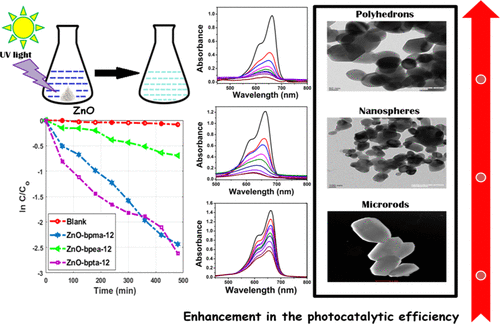Our official English website, www.x-mol.net, welcomes your
feedback! (Note: you will need to create a separate account there.)
Precursor- and Time-Dependent Morphological Evolution of ZnO Nanostructures for Comparative Photocatalytic Activity and Adsorption Dynamics with Methylene Blue Dye.
ACS Omega ( IF 3.7 ) Pub Date : 2020-06-29 , DOI: 10.1021/acsomega.0c01555 Smriti Thakur 1 , Sanjay K Mandal 1
ACS Omega ( IF 3.7 ) Pub Date : 2020-06-29 , DOI: 10.1021/acsomega.0c01555 Smriti Thakur 1 , Sanjay K Mandal 1
Affiliation

|
Diverse ZnO nanostructures were successfully fabricated at 700 °C by direct annealing of 1D Zn(II) coordination polymer precursors, namely, [Zn2(bpma)2(adc)2]n, [Zn2(bpea)2(adc)2]n, and {[Zn2(bpta)2(adc)2]·2H2O}n. The effect of sacrificial ligands present in the precursors as well as a variation in the retention time (6–24 h) during their synthesis resulted in 0D nanospheres, 1D microrods, and 3D polyhedra (with a diamond-like structure) of ZnO. The as-synthesized ZnO nanostructures were characterized by field-emission scanning electron microscopy, transmission electron microscopy, X-ray diffractometry, diffuse reflectance spectroscopy, and Raman spectroscopy. The hexagonal crystal structure was confirmed for all the ZnO samples. A lattice spacing of 0.22 nm has been observed for nanospheres, whereas a lattice spacing of 0.26 nm has been observed for the polyhedra. Their Raman spectra confirm the wurtzite phase of ZnO. UV–vis spectra of ZnO nanostructures exhibit broad peaks in the range of 350–370 nm, and the band gap energies are found to be in the range of 3.02–3.20 eV. Based on the photoluminescence spectra photocatalytic activities of the as-synthesized ZnO nanostructures calcined for 12 h were tested with methylene blue (MB) as a contaminant in an aqueous solution. These results demonstrate that the photocatalytic efficiency of polyhedra is higher than those of nanospheres and microrods. The adsorption kinetics of MB dye by these nanostructures were studied by three different kinetic models—Elovich’s, intraparticle, and pseudo-second-order. The maximum rate of adsorption was observed with the intraparticle diffusion model.
中文翻译:

ZnO 纳米结构的前驱体和时间依赖性形态演化,用于比较亚甲基蓝染料的光催化活性和吸附动力学。
通过直接退火一维 Zn(II) 配位聚合物前驱体,即 [Zn 2 (bpma) 2 (adc) 2 ] n 、[Zn 2 (bpea) 2 (adc) 2 ,在 700 °C 下成功制备了多种 ZnO 纳米结构。 ] n和{[Zn 2 (bpta) 2 (adc) 2 ]·2H 2 O} n 。前体中存在的牺牲配体的影响以及合成过程中保留时间(6-24小时)的变化导致了ZnO的0D纳米球、1D微棒和3D多面体(具有类金刚石结构)。通过场发射扫描电子显微镜、透射电子显微镜、X射线衍射、漫反射光谱和拉曼光谱对合成的ZnO纳米结构进行了表征。所有 ZnO 样品均证实具有六方晶体结构。纳米球的晶格间距为 0.22 nm,而多面体的晶格间距为 0.26 nm。他们的拉曼光谱证实了 ZnO 的纤锌矿相。 ZnO 纳米结构的紫外-可见光谱在 350-370 nm 范围内表现出宽峰,带隙能量在 3.02-3.20 eV 范围内。根据光致发光光谱,用亚甲基蓝(MB)作为污染物在水溶液中测试了煅烧 12 小时的合成 ZnO 纳米结构的光催化活性。这些结果表明多面体的光催化效率高于纳米球和微米棒。 通过三种不同的动力学模型(Elovich 动力学模型、颗粒内动力学模型和准二级动力学模型)研究了这些纳米结构对 MB 染料的吸附动力学。通过颗粒内扩散模型观察到最大吸附速率。
更新日期:2020-07-14
中文翻译:

ZnO 纳米结构的前驱体和时间依赖性形态演化,用于比较亚甲基蓝染料的光催化活性和吸附动力学。
通过直接退火一维 Zn(II) 配位聚合物前驱体,即 [Zn 2 (bpma) 2 (adc) 2 ] n 、[Zn 2 (bpea) 2 (adc) 2 ,在 700 °C 下成功制备了多种 ZnO 纳米结构。 ] n和{[Zn 2 (bpta) 2 (adc) 2 ]·2H 2 O} n 。前体中存在的牺牲配体的影响以及合成过程中保留时间(6-24小时)的变化导致了ZnO的0D纳米球、1D微棒和3D多面体(具有类金刚石结构)。通过场发射扫描电子显微镜、透射电子显微镜、X射线衍射、漫反射光谱和拉曼光谱对合成的ZnO纳米结构进行了表征。所有 ZnO 样品均证实具有六方晶体结构。纳米球的晶格间距为 0.22 nm,而多面体的晶格间距为 0.26 nm。他们的拉曼光谱证实了 ZnO 的纤锌矿相。 ZnO 纳米结构的紫外-可见光谱在 350-370 nm 范围内表现出宽峰,带隙能量在 3.02-3.20 eV 范围内。根据光致发光光谱,用亚甲基蓝(MB)作为污染物在水溶液中测试了煅烧 12 小时的合成 ZnO 纳米结构的光催化活性。这些结果表明多面体的光催化效率高于纳米球和微米棒。 通过三种不同的动力学模型(Elovich 动力学模型、颗粒内动力学模型和准二级动力学模型)研究了这些纳米结构对 MB 染料的吸附动力学。通过颗粒内扩散模型观察到最大吸附速率。









































 京公网安备 11010802027423号
京公网安备 11010802027423号